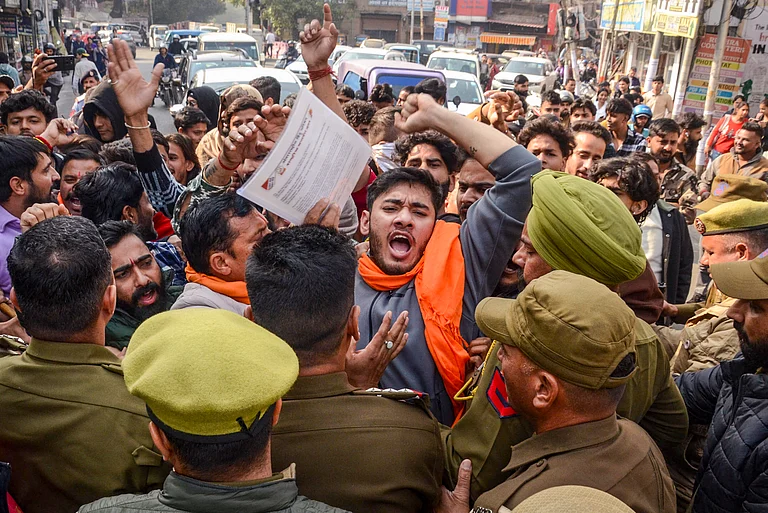Navratri, the grand and most vibrant festival of Hinduism, is fast approaching and will commence from October 3, 2024, to October 12, 2024. The 10-day huge festival holds a significant place in the Hindu community; the devotees celebrate the festival with great fervour and devotion. The enthusiastic festival symbolizes the triumph of good over evil, and each day is dedicated to a different avatar of the goddess Durga. The festival is marked by prayers, fasting, rituals, and celebrations. In this article, we will give details on the Navratri fast, the ritual, and what the dos and don’ts are.
The nine forms of Mata Durga and colours of Navratri to wear during celebration:
03 October (Thursday): Mata Shailputri (RED)
04 October (Friday): Mata Brahmacharini (ROYAL BLUE)
05 October (Saturday): Mata Chandraghanta (YELLOW)
06 October (Sunday): Mata Kushmanda (GREEN)
07 October (Monday): Mata Skandmata GREY)
08 October(Tuesday): Mata Katyayni (ORANGE)
09 October (Wednesday): Mata Kalratri (WHITE)
10 October (Thursday): Mata Mahagauri d (PINK)
11 October (Friday): Mata Siddhidatri (SKY BLUE)
12 October (Saturday): Vijayadashami (Dussehra).
Navratri Date and auspicious timing
According to the Hindu calendar, the Navratri festival is celebrated every year on the Pratipada date of Shukla paksha of Ashwin month, which will start at 12:18 am on October 3, 2024, and will end on October 4, Friday, at 2:58 am. The Kalash Sthapana Muhurat will start from 6:19 am to 7:23 am on October 3, while the Abhijeet Muhurta will start from 11:46 am to 12:33 pm. This year Maa Durga will arrive on Palki or Palanquin. This Palaki ride is considered auspicious in Devi Purana.
What is Ashtami and Navami

The eighth day and the ninth day of Navratri are considered the most important days of Navratri. The eighth day is devoted to Mata Gauri (Parvati Mata). Devotees worship the fierce form of Durga, Mahagauri, and perform Kanya Puja, where young girls are revered as a manifestation of the goddess. While the ninth day is the day of Siddhidatri (an incarnation of Lord Durga). Devotees perform a final aarti and sometimes offer a special meal called Bhandara. It’s a day to express gratitude to the goddess and ask for her blessings.
Navratri Puja rituals and observing fasting
Navratri is a big occasion; it’s an important reminder of spiritual renewal, cultural tradition, and the celebration of life’s vibrant hues. Each day of Navratri is dedicated to Mata Durga and her nine different forms. In these nine days, it is advisable to take a bath every day, worship Mata Durga and seek her blessings. Here is a detail of the rituals during the crucial festival of Navratri.

Kalash Sthapana (Ghatasthapana): On the very first day, you set up a Kalash (holy pot) filled with water or soil, a coconut, and mango leaves to invoke the goddess.
Durga Sthapana: Place the idol or image of Goddess Durga on your home or in Pandal. You can also add idols of Lord Ganesha and other deities.
Daily Puja: Light a diya (lamp) every morning and evening. Chant Durga mantras and offer flowers, fruits, and sweets like prasad. Recite the Durga Chalisa and the Durga Saptashati and seek Mata Durga’s blessing with your family and friends.
Aarti and Bhajans: Conclude the puja with Aarti (devotional songs) and bhajans, which invoke blessings.
Kanya Puja: A very important day of Navratri is Kanya Pujan. On Ashtami or Navami, invite young girls (representing the goddess) and offer them food, new clothes, or gifts. This ritual, called Kanjak or Kanya Pujan, is a symbol of respect for the goddess.
Offering Saree to the Goddess: Traditionally, a saree is offered to the goddess during the puja, usually on Ashtami or Navami. This is done to seek blessings for family well-being, prosperity, and protection.
Fasting during Navratri Dos and Don’ts

Keeping fast not only makes your wishes true but also brings peace and devotion to your life. Some devotees observe Nirjala fast or partial fasting while some opt for Falahar fast during Navratri depending on their ability and devotion. During Navratri, there are some strict dos and don’ts that must be followed to make your festival fast-worthy
Dos
Stay hydrated while observing fast. You can also consume drinks like coconut water, lemon water, buttermilk, and fresh fruit juices.
Start your day freshly after taking a bath and then worship Mata Durga offer her prayer, Bhog, and seek her blessing.
You can eat sabudana (tapioca pearls), kuttu (buckwheat flour), kheer, and singhara (water chestnut flour) during the fast. (sabudana is a cooling food and contains starch and that’s why it is preferable during fasting, while kuttu contain fibre, magnesium and other vitamins which give nutrients to our body and provide energy boost during fast.
Keeping fast is important but what is more important is chanting Mata’s shlokas and remembering her. Don't spread hatred or share negative thoughts during the occasion. Prepare Prasad for Mata Durga and offer her sweets.
You can have dairy products like milk, curd, paneer, and other dairy products during the fast if you are not keeping Nirjala. Also, Sendha Namak (rock salt) can be used in food, as it’s considered pure for fasting purposes.
Fasting Don'ts:
It is strictly advisable to avoid Tamasic food like meat, eggs, onion, and garlic during fasting. Refrain from consuming alcohol or cigarettes.
Avoid wheat, rice, barley, and any other grains or cereals, as it is strictly not allowed during fasting.
Table salt or sea salt should not be used; instead, opt for rock salt as rock salt is considered pure.
Avoid fasting if you are not well. Also, for pregnant ladies or any health condition where fasting is not allowed, don't keep it.
Try to keep your mind calm and composed during fast, don't fight or think of negative thoughts while keeping fast.
Navratri is a time of spiritual rejuvenation, devotion, and fasting. By adhering to the traditional dos and don’ts of fasting, performing daily puja rituals, and following auspicious colour codes, you can make the most of this auspicious festival. Embrace the divine feminine energy and seek the blessings of Goddess Durga for health, prosperity, and happiness throughout the year.



























